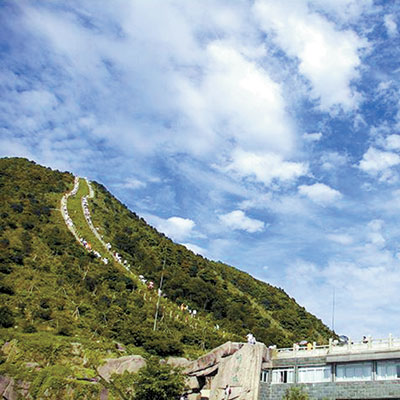
As the Double Ninth Festival is celebrated in the golden season of autumn, at harvest time, it is usually perfect for outdoor activities. The bright clear weather and the joy of the harvest make for a festive atmosphere.
According to an account of Shenzhen's history, the mountains where ancient locals used to climb to celebrate the festival were Wutong Mountain in Luohu District and Yangtai Mountain and Phoenix Mountain in Bao'an District.
These mountains remain popular hiking spots in the present day. Let's take a look at these places and perhaps, do as the ancient locals did, go hiking in these mountains and enjoy the autumn views during the Double Ninth Festival.
The mountain is located in Bao'an District with a main peak of 587.3 meters. Although it's not high enough to challenge the status of Wutong Mountain, Yangtai Mountain enjoys a higher reputation than Wutong Mountain among local hikers for its annual international hiking festival and cliff-climbing competition. This year the hiking festival will be held tomorrow.
To locals, Yangtai Mountain is also known as the "Mountain of Heroes" because it served as a hiding spot for democratic patriots like Mao Dun, Zou Taofen and He Xiangning who escaped from Hong Kong when it was occupied by the Japanese Army during the War of Resistance Against Japanese Aggression (1936-1945).
Blessed with plentiful rain, the Mountain is home to luxuriant trees and native animals. The greenery of Yangtai earned it a place in Shenzhen's latest list of top eight popular scenic spots. At the foot of the mountain, there are a dozen reservoirs. Large and small waterfalls plunge into the valleys, forming brooks and ponds. A natural cave in the side of the mountain, Qiniang Cave, is home to a spring that supplies water to Hakka people living at the foot of the mountain.
Route one: start from Longyan Village (龙眼村)
A stone-paved hiking path starts from the village and leads to the peak. This is the traditional hiking route where the annual hiking competition is held. It takes around one and a half hours to reach the peak.
Route two: start from Huangjinkeng (黄金坑)
There are no man-made pathways. If you choose this route, head north across litchi trees and wild jungles, and you will reach a small peak in around 40 minutes. Head northwest and follow the mountain ridge, you will reach the peak of Yangtai mountain in three hours.
With the title of "the highest in Shenzhen," Wutong Mountain is always first on the list of Shenzhen's natural resorts. At a height of 944 meters, the mountain is a visual treat for tourists. There are forest parks which are the habitat for numerous birds and animals. From the top of the mountain trhere is an amazing view of Hong Kong.
With natural beauty and well-planned hiking routes, it is also the first choice for hikers on Double Ninth Festival. This year, a citywide mountaineering competition will be held at the mountain tomorrow and Wednesday to celebrate the traditional festival.
Route one
Wutongshan Village — mountain road — parking lot — Haohan Slope — Big Wutong Peak
This is the traditional and safest hiking route, with most of the journey along a well-paved winding mountain road. The only challenge lies in climbing Haohan Slope, which consists partly of stone-paved steps and earth lanes that ascend at 60 to 80 degrees.
Route two
Wutongshan Village — Taishan Brook — Hulu Pond — Wutong Peak
This route was once the favorite of local outdoor lovers. But as man-made pathways extended to the cross jungle route and more visitors followed the way to the brook, the route was abandoned by the outdoor zealots and became popular among visitors.
Route three Wutongshan Village — Wutonghshan Water Plant — Small Wutong Mountain — Big Wutong Mountain
This is a more challenging route which involves hiking beside brooks and walking along steep cliffs. But there is no real threat to safety. Although lesser known, the route is more fun for outdoor lovers.
Double Ninth Festival
Tuesday marks the traditional Double Ninth Festival, known as Chongyang Festival in Chinese.
The festival falls on the ninth day of the ninth lunar month, which falls on Tuesday this year. In "The Book of Changes," one of the Confucian classics, the number "nine" was thought to be the Yang character, meaning masculine or positive. So the number nine in both month and day creates the Double Ninth Festival, or Chongyang Festival. Chong in Chinese means "double." As double ninth was pronounced the same as the word to signify "forever" — both are "jiu jiu" — the Chinese ancestors considered it an auspicious day worth celebrating. That's why ancient Chinese began to celebrate this festival in antiquity.
The custom of ascending a height to avoid epidemics on the day was passed down through history. Therefore, the festival is also called "Height Ascending Festival." Climbing a hill is one of the inevitable celebrations of the festival. The height people will aspire to reach is usually a mountain or a tower.
(Shenzhen Daily October 13, 2008)